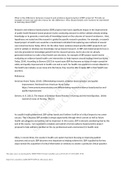Essay
UNIT 2C applied science
- Institution
- PEARSON (PEARSON)
Unit 2 Aim C up to Distinction level. I analyse Thin layer chromatography and paper chromatography for plant pigments and amino acids. I analyse their RF values and what they mean. It includes all values l and calculations requires to get a Distinction.
[Show more]












